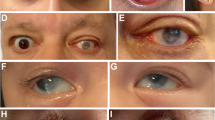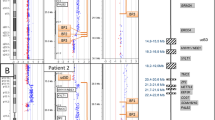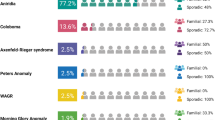Abstract
In 65 patients, who had unexplained ocular developmental anomalies (ODAs) with at least one other birth defect and/or intellectual disability, we performed oligonucleotide comparative genome hybridisation-based microarray analysis (array-CGH; 105A or 180K, Agilent Technologies). In four patients, array-CGH identified clinically relevant deletions encompassing a gene known to be involved in ocular development (FOXC1 or OTX2). In four other patients, we found three pathogenic deletions not classically associated with abnormal ocular morphogenesis, namely, del(17)(p13.3p13.3), del(10)(p14p15.3), and del(16)(p11.2p11.2). We also detected copy number variations of uncertain pathogenicity in two other patients. Rearranged segments ranged in size from 0.04 to 5.68 Mb. These results show that array-CGH provides a high diagnostic yield (15%) in patients with syndromal ODAs and can identify previously unknown chromosomal regions associated with these conditions. In addition to their importance for diagnosis and genetic counselling, these data may help identify genes involved in ocular development.
Similar content being viewed by others
Log in or create a free account to read this content
Gain free access to this article, as well as selected content from this journal and more on nature.com
or
References
Fitzpatrick DR, van Heyningen V : Developmental eye disorders. Curr Opin Genet Dev 2005; 15: 348–353.
Hornby SJ, Gilbert CE, Rahi JK et al: Regional variation in blindness in children due to microphthalmos, anophthalmos and coloboma. Ophthalmic Epidemiol 2000; 7: 127–138.
Morrison D, FitzPatrick D, Hanson I et al: National study of microphthalmia, anophthalmia, and coloboma (MAC) in Scotland: investigation of genetic aetiology. J Med Genet 2002; 39: 16–22.
Mihelec M, St Heaps L, Flaherty M et al: Chromosomal rearrangements and novel genes in disorders of eye development, cataract and glaucoma. Twin Res Hum Genet 2008; 11: 412–421.
Kallen B, Tornqvist K : The epidemiology of anophthalmia and microphthalmia in Sweden. Eur J Epidemiol 2005; 20: 345–350.
Stoll C, Alembik Y, Dott B, Roth MP : Congenital eye malformations in 212,479 consecutive births. Ann Genet 1997; 40: 122–128.
Lee C, Scherer SW : The clinical context of copy number variation in the human genome. Expert Rev Mol Med 2010; 12: e8.
Raca G, Jackson CA, Kucinskas L et al: Array comparative genomic hybridization analysis in patients with anophthalmia, microphthalmia, and coloboma. Genet Med 2011; 13: 437–442.
Balikova I, de Ravel T, Ayuso C et al: High frequency of submicroscopic chromosomal deletions in patients with idiopathic congenital eye malformations. Am J Ophthalmol 2011; 151: 1087–1094, e1045.
Winer J, Jung CK, Shackel I, Williams PM : Development and validation of real-time quantitative reverse transcriptase-polymerase chain reaction for monitoring gene expression in cardiac myocytes in vitro. Anal Biochem 1999; 270: 41–49.
Schiff M, Delahaye A, Andrieux J et al: Further delineation of the 17p13.3 microdeletion involving YWHAE but distal to PAFAH1B1: four additional patients. Eur J Med Genet 2010; 53: 303–308.
Koolen DA, Pfundt R, de Leeuw N et al: Genomic microarrays in mental retardation: a practical workflow for diagnostic applications. Hum Mutat 2009; 30: 283–292.
Xiang B, Zhu H, Shen Y et al: Genome-wide oligonucleotide array comparative genomic hybridization for etiological diagnosis of mental retardation: a multicenter experience of 1499 clinical cases. J Mol Diagn 2010; 12: 204–212.
Aldinger KA, Lehmann OJ, Hudgins L et al: FOXC1 is required for normal cerebellar development and is a major contributor to chromosome 6p25.3 Dandy-Walker malformation. Nat Genet 2009; 41: 1037–1042.
Nolen LD, Amor D, Haywood A et al: Deletion at 14q22-23 indicates a contiguous gene syndrome comprising anophthalmia, pituitary hypoplasia, and ear anomalies. Am J Med Genet A 2006; 140: 1711–1718.
Dateki S, Kosaka K, Hasegawa K et al: Heterozygous orthodenticle homeobox 2 mutations are associated with variable pituitary phenotype. J Clin Endocrinol Metab 2010; 95: 756–764.
McCabe MJ, Alatzoglou KS, Dattani MT : Septo-optic dysplasia and other midline defects: the role of transcription factors: HESX1 and beyond. Best Pract Res Clin Endocrinol Metab 2011; 25: 115–124.
Ragge NK, Brown AG, Poloschek CM et al: Heterozygous mutations of OTX2 cause severe ocular malformations. Am J Hum Genet 2005; 76: 1008–1022.
Schilter KF, Schneider A, Bardakjian T et al: OTX2 microphthalmia syndrome: four novel mutations and delineation of a phenotype. Clin Genet 2011; 79: 158–168.
Alfonso J, Fernandez ME, Cooper B, Flugge G, Frasch AC : The stress-regulated protein M6a is a key modulator for neurite outgrowth and filopodium/spine formation. Proc Natl Acad Sci USA 2005; 102: 17196–17201.
Katoh H, Negishi M : RhoG activates Rac1 by direct interaction with the Dock180-binding protein Elmo. Nature 2003; 424: 461–464.
Sawyer JM, Harrell JR, Shemer G, Sullivan-Brown J, Roh-Johnson M, Goldstein B : Apical constriction: a cell shape change that can drive morphogenesis. Dev Biol 2010; 341: 5–19.
Eiraku M, Takata N, Ishibashi H et al: Self-organizing optic-cup morphogenesis in three-dimensional culture. Nature 2011; 472: 51–56.
Nagamani SC, Zhang F, Shchelochkov OA et al: Microdeletions including YWHAE in the Miller-Dieker syndrome region on chromosome 17p13.3 result in facial dysmorphisms, growth restriction, and cognitive impairment. J Med Genet 2009; 46: 825–833.
Fernandez BA, Roberts W, Chung B et al: Phenotypic spectrum associated with de novo and inherited deletions and duplications at 16p11.2 in individuals ascertained for diagnosis of autism spectrum disorder. J Med Genet 2010; 47: 195–203.
Bochukova EG, Huang N, Keogh J et al: Large, rare chromosomal deletions associated with severe early-onset obesity. Nature 2010; 463: 666–670.
Walters RG, Jacquemont S, Valsesia A et al: A new highly penetrant form of obesity due to deletions on chromosome 16p11.2. Nature 2010; 463: 671–675.
Hernando C, Plaja A, Rigola MA et al: Comparative genomic hybridisation shows a partial de novo deletion 16p11.2 in a neonate with multiple congenital malformations. J Med Genet 2002; 39: E24.
Bardakjian TM, Kwok S, Slavotinek AM, Schneider AS : Clinical report of microphthalmia and optic nerve coloboma associated with a de novo microdeletion of chromosome 16p11.2. Am J Med Genet A 2010; 152A: 3120–3123.
Kumar RA, Marshall CR, Badner JA et al: Association and mutation analyses of 16p11.2 autism candidate genes. PLoS One 2009; 4: e4582.
Lee C, Iafrate AJ, Brothman AR : Copy number variations and clinical cytogenetic diagnosis of constitutional disorders. Nat Genet 2007; 39: S48–S54.
Rodriguez-Revenga L, Mila M, Rosenberg C, Lamb A, Lee C : Structural variation in the human genome: the impact of copy number variants on clinical diagnosis. Genet Med 2007; 9: 600–606.
Anney R, Klei L, Pinto D et al: A genome-wide scan for common alleles affecting risk for autism. Hum Mol Genet 2010; 19: 4072–4082.
Debette S, Bis JC, Fornage M et al: Genome-wide association studies of MRI-defined brain infarcts: meta-analysis from the CHARGE Consortium. Stroke 2010; 41: 210–217.
Baranzini SE, Wang J, Gibson RA et al: Genome-wide association analysis of susceptibility and clinical phenotype in multiple sclerosis. Hum Mol Genet 2009; 18: 767–778.
Xu B, Woodroffe A, Rodriguez-Murillo L et al: Elucidating the genetic architecture of familial schizophrenia using rare copy number variant and linkage scans. Proc Natl Acad Sci USA 2009; 106: 16746–16751.
Bendavid C, Rochard L, Dubourg C et al: Array-CGH analysis indicates a high prevalence of genomic rearrangements in holoprosencephaly: an updated map of candidate loci. Hum Mutat 2009; 30: 1175–1182.
Maas NM, Van de Putte T, Melotte C et al: The C20orf133 gene is disrupted in a patient with Kabuki syndrome. J Med Genet 2007; 44: 562–569.
Kuniba H, Yoshiura K, Kondoh T et al: Molecular karyotyping in 17 patients and mutation screening in 41 patients with Kabuki syndrome. J Hum Genet 2009; 54: 304–309.
Bradley WE, Raelson JV, Dubois DY et al: Hotspots of large rare deletions in the human genome. PLoS One 2010; 5: e9401.
Xu J, Mashimo T, Sudhof TC : Synaptotagmin-1, -2, and -9: Ca(2+) sensors for fast release that specify distinct presynaptic properties in subsets of neurons. Neuron 2007; 54: 567–581.
Acknowledgements
We thank the patients and their families who participated in this study and the medical staff involved in the diagnosis of syndromal ocular development anomalies.
Author information
Authors and Affiliations
Corresponding author
Ethics declarations
Competing interests
The authors declare no conflict of interest.
Additional information
Supplementary Information accompanies the paper on European Journal of Human Genetics website
Supplementary information
Rights and permissions
About this article
Cite this article
Delahaye, A., Bitoun, P., Drunat, S. et al. Genomic imbalances detected by array-CGH in patients with syndromal ocular developmental anomalies. Eur J Hum Genet 20, 527–533 (2012). https://doi.org/10.1038/ejhg.2011.233
Received:
Revised:
Accepted:
Published:
Issue date:
DOI: https://doi.org/10.1038/ejhg.2011.233
Keywords
This article is cited by
-
Genetics of anophthalmia and microphthalmia. Part 1: Non-syndromic anophthalmia/microphthalmia
Human Genetics (2019)
-
Haploinsufficiency of BMP4 and OTX2 in the Foetus with an abnormal facial profile detected in the first trimester of pregnancy
Molecular Cytogenetics (2017)
-
Glaucoma spectrum and age-related prevalence of individuals with FOXC1 and PITX2 variants
European Journal of Human Genetics (2017)
-
Molecular characterization of a novel ring 6 chromosome using next generation sequencing
Molecular Cytogenetics (2016)
-
Array-CGH analysis in Rwandan patients presenting development delay/intellectual disability with multiple congenital anomalies
BMC Medical Genetics (2014)



